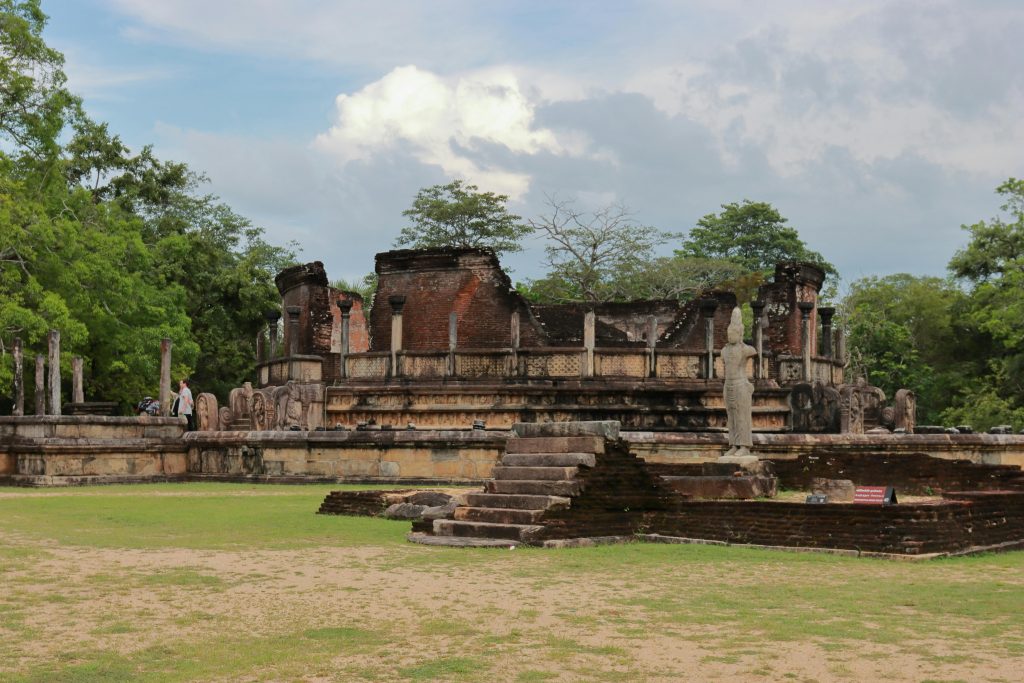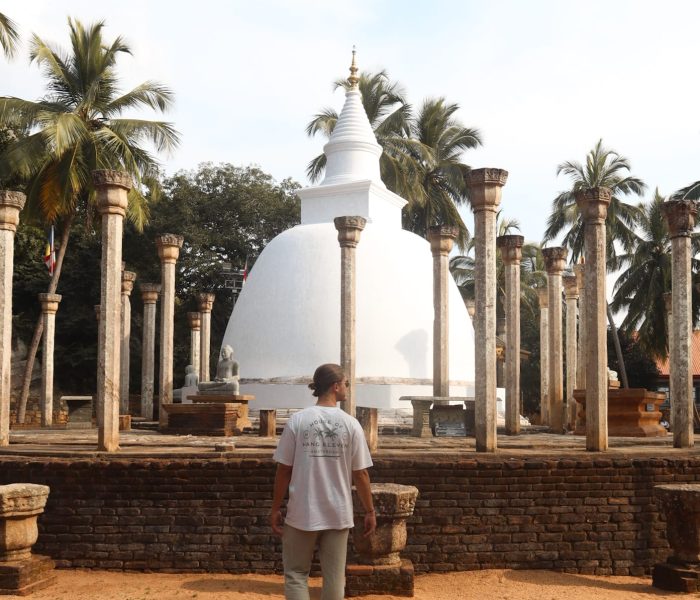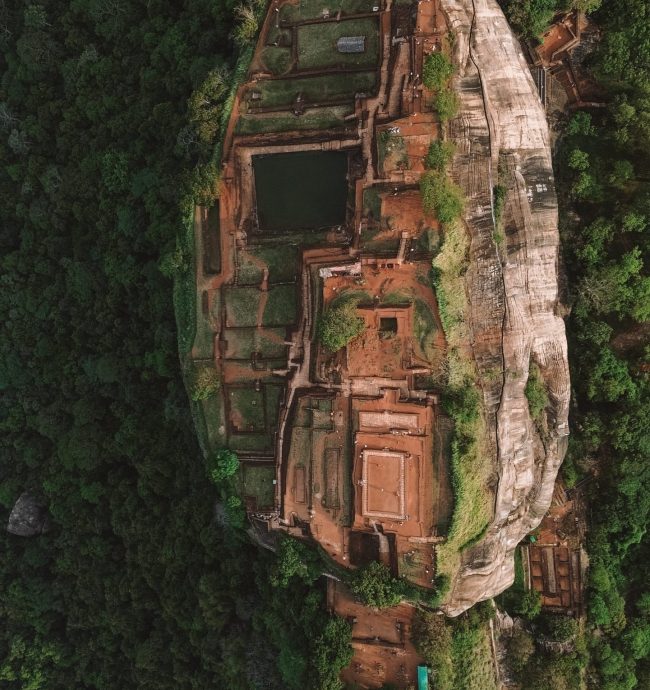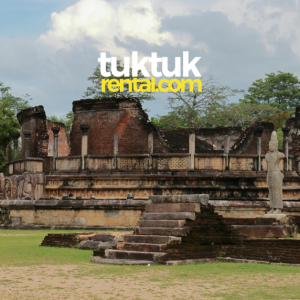Author: Kalpana Sunder
Table of Contents

Sri Lanka has a documented history of over 3,000 years. For instance, its position on the maritime Silk Road gave it a rich history of trade with many countries. Many of its historic sites reflect a rich Buddhist heritage and the powerful kingdoms that once ruled the island. In fact, Sri Lanka’s Cultural Triangle lies in the centre of the island. It covers the World Heritage sites of Anuradhapura, Polonnaruwa, Sigiriya, Dambulla, and Kandy. Besides these famous locations, countless murals, cave paintings, statues, and ruined monasteries are spread across the country. Here is our pick of top ancient wonders to explore.
Ramble through the ruins of Polonnaruwa
Polonnaruwa was the ancient capital city for more than three centuries. You can find it 213 km from Colombo, behind three concentric city walls. Inside, you’ll discover temple ruins, orange sand roads, and majestic stupas. This city became the capital after King Chola Rajaraja I conquered and destroyed Anuradhapura. Consequently, both Sinhalese and Chola rulers from South India occupied it.
You can explore the city through four main locations: the Royal Palace, the Quadrangle, Aluhana Pirivena (Northern Group), and Gal Vihara. The main attraction here is Gal Vihara, a collection of vast Buddha sculptures. In addition, a sacred structure known as a “gedige” houses a large headless Buddha statue.
Top Tip: Travelers can rent bicycles or tuk-tuks for an efficient tour, as the site is vast. Since Polonnaruwa is home to many religious sites, it is essential to dress modestly.
Admire the stupas of Anuradhapura
One of the ancient world’s largest monastic cities, founded in the 4th century B.C, and sacred to the Buddhists, Anuradhapura, a UNESCO heritage site, in the northern central province of Sri Lanka, was a ruling capital city until the 11th century.
Explore the ancient city’s sprawling complex of shrines, stupas, tanks, temples and monasteries. The red brick Jetavana Dagoba, was at the time of its construction, the third tallest structure in the world, after the pyramids of Giza. Ramble through the ruins of the Abhayagiri Monastery, the largest monastery for over 600 years, which housed more than 5000 monks. Admire the Kuttam Pokuna, ornamental twin ponds which are an ancient engineering marvel and the ‘rice-boats’ in the remains of the Mahapali Refectory- stone troughs which used to be filled with rice for the monks.
Top Tip: The entrance fee for the archaeological complex of Anuradhapura is $25. A bicycle or tuk tuk is the best way to get around.

Have a visual feast in Dambulla
The Dambulla caves are a UNESCO World Heritage Site dating back to the 1st century B.C. They are located on a rocky outcrop 73 km from Kandy, and you can access them by climbing 364 steps. Buddhism has a tradition of rock-cut caves where monks meditated away from human habitation. Interestingly, these caves originally served as a hide-out for dethroned kings. In fact, these huge rock caves once provided refuge to King Vattagamani after he lost his kingdom.
Inside, the caves are a riot of paintings, murals, and Buddha statues. King Nissankamalla gilded many of the statues. As a result, people began to call the caves Ran Giri, or Golden Rock. There’s an enormous collection of Buddha statues here of all sizes and poses. Artists built them out of brick, wood, and granite and then covered them with stucco and paint.
Top Tip: Remember that there is a steep flight of steps to be climbed to the caves. The entrance ticket needs to be bought before climbing to the top.
Pray at the famous Tooth Temple of Kandy
The Temple of the Sacred Tooth complex in Kandy is a UNESCO World Heritage site. This hill town now houses Sri Lanka’s most important Buddhist relic – the left canine tooth of Buddha. The brilliantly white Dalada Maligawa is one of Buddhism’s most venerated sites. It enshrines the Buddha’s tooth inside a jeweled casket. Kandyan drummers, frangipani offerings, pagoda roofs, and a moat all contribute to making this a great experience.
Top tip: The temple is open from 05.30 to 20.30. It can sometimes be very crowded. Authorities follow strict rules, body checks, and procedures before you can enter the temple.
Climb the rock at Sigiriya
Sigiriya is a testament to ancient engineering. It is a vertiginous outcrop of gneiss rock rising 660 feet out of the surrounding countryside. Its turbulent history began in the 5th century A.D. during a power struggle between King Dhatusena’s two sons, Kashyapa and Moggallana. A paranoid Kashyapa prepared for his brother’s invasion. Therefore, he defiantly built an impregnable fortress and ‘pleasure palace’ on the volcanic outcrop, Sigiriya Rock. Inside the fortress, he created a lavish palace complex with stunning gardens, reservoirs, and frescoes.
You can ascend the rickety stairs to a sheltered gallery in the rock face. Here, you will find the famed ‘Sigiriya frescoes’. These are paintings of sensuous, narrow-waisted women in diaphanous garments, holding water lilies. Finally, the reward for reaching the top is the 360-degree view of the rolling hills and the water gardens below.
Top Tip: The climb begins at the foot of the rock, along a well-marked path leading to the summit. The path is partly paved and partly with stone steps. It’s a hike of moderate intensity.

Go back in time at Pahiyangala cave
This cave is in the Kalutara District, just 40 km from Colombo. It gets its name from the Chinese Mahayana Buddhist priest Fa-Hsien, who visited in the 5th century. It is believed he lived for several months in the Pahiyangala cave. In addition, archaeologists discovered the remains of a 37,000-year-old prehistoric society in this gargantuan cave. It is also home to a Buddhist temple. A 40-foot-long reclining Buddha statue greets visitors at the temple.
Top Tip: It’s a slightly difficult 20-minute walk up stone steps with no railings to reach the top. The excavation pit is open to visitors.
Admire the ancient statues of Buduruvagala
Buduruvagala, located 88 km from Yala, is famous for its magnificent rock carvings. It features seven ancient statues from the 10th century. The gigantic Buddha statue with its stuccoed robe is the showstopper. In fact, it is the largest standing Buddha on the island. The sculptures of Buduruvagala also include many Bodhisattva images. Although its history is not fully known, many believe it was once a hermitage for monks.
Top tip: Timings 8 am to 5 pm. Entry is free.
You might also consider downloading the Tuktukrental Travel App. It features offline maps, offbeat recommendations and even helps fellow tuktuk-ers on the road connect for information or just a few post drive beers – or the local Sri Lankan arrack if you are feeling adventurous!



